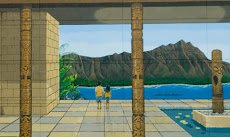|
| Wisconsin’s Natives Tell Their Own Histories
By Suzanne Westerly
December 30, 2002
Like branches weighed down by a heavy snowfall, the 12 Indian nations of Wisconsin have been burdened with the weight of almost 200 winters of traumatic events. But like branches after a spring thaw, these nations are again standing strong today.
Author Patty Loew, Ph.D., an enrolled member of the Bad River Band of Lake Superior Ojibwe, has written a powerful and important new book, “Indian Nations of Wisconsin: Histories of Endurance and Renewal.” In her book, Loew weaves together origin stories, ancient songs, art, and symbolism with the historical perspectives of Wisconsin’s first people. She also discusses the critical Native issues of today: the economic and political developments along with the ongoing struggles over the environment, treaty rights, and sovereignty.
Lowe has long been frustrated by books about Wisconsin’s Natives based on “white” sources: missionary accounts, traders’ journals, and government documents. When asked to write the text for a large exhibit on Indian nations for Wisconsin’s sesquicentennial, Loew enthusiastically accepted. It was an opportunity to educate the state’s residents about the Natives’ triumphs over centuries of injustice.
Loew’s intensive research led to her absorbing “Indian Nations of Wisconsin.” You’ll find yourself reading every word, even the chapter notes in the back, and checking her recommended resources (videotapes, CD-ROMs, Web sites) and further reading. This book should be part of Wisconsin’s the high school curriculum, but it’s valuable for anyone interested in a genuine history of the state.
In the preface Loew writes, “I have attempted to use as many Native sources as possible: speeches delivered by chiefs during treaty negotiations, origin stories, songs, legends, cave paintings, Native newspapers, and so on. I have tried to refer to the Native people as they refer to themselves. I use the word Haudenosaunee instead of Iroquois . . . Mesquakie instead of Fox . . . Anishinabe or Ojibwe instead of Chippewa.”
In exploring Wisconsin’s rich Native heritage, Loew has created compact yet comprehensive tribal histories. We learn about the uniqueness of each Indian community: the Ho-Chunk, Menominee, Potawatomi, Oneida, Mohican, Brothertown (not federally recognized), and six bands of Ojibwe. Loew mentions their relations with the Dakota, Sauk, Mesquakie, Mascouten, Kickapoo, and other tribes.
As Loew explains, with the advent of French and English fur traders, life for Wisconsin’s Natives would never be the same. The traders introduced firearms, debilitating alcohol, and a variety of European goods that Natives became dependent on, to the detriment of their way of life. Soon came devastating waves of European diseases and missionaries, who imposed Christianity on the Natives, often forcefully.
To better elucidate history, Loew discusses how Euro-American wars (the American Revolution, the War of 1812, the Civil War, World War I and II) triggered problems for Wisconsin’s tribes, especially the unrelenting encroachment onto their lands. We learn why Natives chose to fight with or against the French, English, and Americans.
Loew exposes the truth about U.S. treaties with Wisconsin’s tribes. For hundreds of years, and still today, Wisconsin’s Natives have determinedly fought for a land base as coercive treaties have taken their homelands. For instance, Loew describes the dilemma of the Brothertown Tribe of Wisconsin. In 1878, Congress acknowledged Brothertown as a tribe but appointed five trustees to oversee the sale of unallotted Brothertown land. Today, the tribe works optimistically to become federally recognized again.
Throughout her book Loew illustrates the significant impact the French, English, and American governments have had on Wisconsin’s Natives. Damaging government policies have included the establishment of reservations; allotment and fractionalization; the Browning ruling, which sent children to boarding schools; the Indian Reorganization Act; the New Deal assimilation programs; and termination and relocation.
We also learn about the victories of admirable warriors such as war chief Little Turtle (Miami), Tecumseh (Shawnee), Black Hawk (Sauk), and Chief Buffalo (Ojibwe). Bringing us into contemporary times, Loew touches upon modern day warriors: the activists in the pan-Indian and Red Power movements, the American Indian Movement (AIM), and individuals like Dorothy Davids.
“They tried to erase us,” said Davids (Mohican) of the boarding schools Indian children were forced to attend. She was the first American Indian woman to graduate from the University of Wisconsin-Stevens Point, going on to earn a master’s degree. Davids acknowledged the positive side of the boarding-school experience: learning to read and write. Eventually, she said, “We were able to stand up and criticize some of the government’s policies.”
One conflict started in 1974 when two Ojibwe brothers, Mike and Fred Tribble of Lac Courte Oreilles, were arrested for ice fishing on a lake off their reservation but within territory the Ojibwe claimed for hunting and fishing. In Chapter 5, Loew quotes one of the brothers: “When they said I was doing it illegally,” Mike Tribble recounted, “I took the treaty out of my back pocket and I said, ‘No, I’m doing this under treaty rights.’”
When the Ojibwe went spear-fishing the following year, angry protestors tried to stop them with legal action, political pressure, death threats, and violence, including gunshots fired at boats. The Ojibwe and their supporters fought back with nonviolent tactics. By 1991, the U.S. Supreme Court reaffirmed the right of the Lake Superior Ojibwe to hunt, fish, and gather on lands ceded in Minnesota, Michigan, and Wisconsin.
“Indian Nations of Wisconsin” shows repeatedly that, despite tremendous adversity, Native Americans have always had enough resilience to adapt and succeed. Now they’re a growing political power.
Wisconsin’s Native nations are experiencing a renaissance, Loew writes. Many are reaping the economic benefits of Indian gaming. They’re funding projects such as roads, health-care services, elder housing, community centers, schools, and Head Start. They’re building an economic infrastructure and seeing entrepreneurship blossom.
Casino profits are helping in other ways. Tribes are cleaning up environmental messes and hiring attorneys to fight mining companies and other corporations that have ravaged tribal lands.
Loew also notes how Wisconsin’s Natives are returning to their cultural roots rather than leaving the reservations behind. She attributes this in part to the availability of education, jobs, and other advantages non-Natives take for granted.
Loew superbly integrates volumes of information, fascinating photographs, and insightful interviews into “Indian Nations of Wisconsin.” She leaves the reader feeling hopeful in her engrossing and enlightening new book.
Patty Loew, a recipient of the Outstanding Service Award of the Great Lakes Intertribal Council, is an assistant professor in the Department of Life Sciences Communication at the University of Wisconsin-Madison, a producer for WHA-TV (PBS), and co-host of a weekly news and public affairs program on Public Television in Wisconsin. She has produced several award-winning documentaries and written dozens of scholarly and general-interest articles on Native topics.
“Indian Nations of Wisconsin: Histories of Endurance and Renewal” is published by the Wisconsin Historical Society Press (www.shsw.wisc.edu/publications). Suzanne Westerly can be reached at suzannewesterly@earthlink.net
| |






























